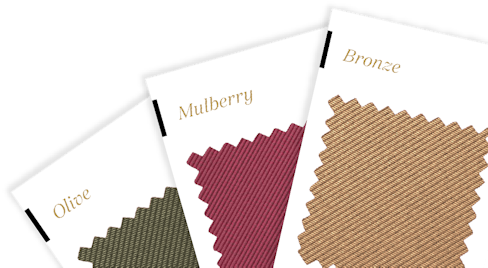Do You Wear a Belt with a Tuxedo? (Answered!)

Just got engaged? Check out our new Groom's Guide!
The choice of whether or not to wear a belt is up to you, and you can’t really go wrong regardless of the option you choose. But it all gets trickier when you have a tuxedo because normal belt rules don’t apply. There are some instances when a belt can look great with a tux, and others where it doesn’t work at all.
Figuring out whether a belt is right for your tux is the dilemma facing you right now. Keep reading to discover when a belt works, when it doesn’t, and some alternatives if you want to go belt-less but still find a way to accessorize.
To Belt or Not to Belt: The Tuxedo Question
To paraphrase Shakespeare – To belt or not to belt? That is the question. And it’s a big question, too. When you get it right, a belt can be a subtle accessory that accentuates the look of a tux without drawing the eye away from the main event, i.e., the jacket, shirt, and bow tie combo. But if you get it wrong, a belt can look garish or bulky, making it out of place in an otherwise traditional look.
So, what’s the answer to the question of whether you wear a belt or not? Let’s find out.
The Dos and Don’ts of Wearing a Belt with a Tuxedo
Starting with the simplest answer – yes, you can wear a belt with a tuxedo. It’s a stylistic choice that’s up to you, but it’s a choice that comes with some baggage. If you go for the belt, you have to get it right, and these basic dos and don’ts are a good starting point:
Do – Make sure your belt matches the shoes you wear, as you’ll discover later in the article.
Don’t – Wear a belt when you’re wearing a cummerbund. In addition to serving the function of a belt (cummerbunds wrap over the belt line), you’ll end up with an unsightly belt imprint on your cummerbund if you try to combine the two.
Do – Pay attention to your trousers, particularly the belt loops. You don’t see any belt loops? That’s a sign that your style of tux isn’t made with belts in mind.
Don’t – Combine a belt with suspenders. Like a cummerbund, suspenders serve the same purpose as a belt. Plus, you risk over-accessorizing and creating a howdy-doody look by combining a belt with suspenders.
Perfecting the Art of Wearing a Belt with a Tuxedo
Those dos and don’ts clue you into the fact that wearing a belt with a tux is a contentious issue. Some major fashion trendsetters, including GQ Magazine, even take a clear stance – belts never go with formalwear.
That stance is a little harsh, and perhaps restrictive for people who want to use belts to create a specific look. Nevertheless, wearing a belt with a tux is an art form, and if you’re not a master of that art, you risk creating a mismatched look. But if you insist on taking your belt-based paintbrush to your tux, these are the steps that help you find a belt that complements your tuxedo.
Step 1 – Selecting the Perfect Belt for Your Tuxedo
It all starts with the belt design.
The big and bulky belts that look perfect with your jeans look garish and out of place with a tux. Huge buckles are a no-no, as are belts that are so large that they take up almost as much space as a cummerbund.
Instead, the factors to consider when choosing your belt are its style, color, and material.
Style is simple – slim is always better. That applies to both traditional tuxes and their more modern slimline variants for the simple reason that the tux is the star of the show. The belt isn’t. Your belt exists for a practical purpose, much more so than a stylistic purpose, and going slim ensures you get a belt that’s in line with the subtle design of your tux.
Color is also simple because you’ll generally match your belt to your shoes. Again, more on that later, but the goal is to wear a belt that complements the secondary elements of your tuxedo, rather than standing out from them. Often, you’ll go with a black belt because black shoes are the norm for tuxes.
Finally, materials. Leather (or a leather substitute) is usually the best option, especially if you can get a belt with a matte texture. That texture contrasts the sheen of a tuxedo nicely, while not being so overt that it catches the eye ahead of the tux.
Note that fabric belts often look out of place with a tux. They’re not smooth enough to work in tandem with the sleek lines of a tuxedo jacket or trousers, causing them to stand out a little too much.
Ensuring Harmony: Matching Your Belt with Your Shoes
It’s been touched on a couple of times, but it’s worth emphasizing here – a belt should match your shoes. Hollywood star Ashton Kutcher makes that clear in his fashion advice to men: “Your shoes have to match your belt. That’s rule number one for guys. You can’t put the brown shoes with the black belt. Or a brown belt with a black wristwatch. Just don’t do it!”
Ashton slipped in a little note about matching a belt to your watch there, too, and the point he’s making is that harmony is the goal with your tuxedo accessories. Color mismatches ruin that harmony. They stand out, and not in a good way, looking out of place while indicating that the wearer doesn’t have a sense of style.
Of course, there are layers to this color matching. You’ll start with the tuxedo itself before choosing shoes that match. Black and brown are both fine choices, but the type of shoes limits your belt options.
Positioning Your Belt for Optimal Fit and Look
Once you’ve found a suitable belt, you may face another problem – most tuxedo trousers don’t come with belt loops. Generation Tux highlights this in a 2018 post about how to wear tuxedo pants, along with a bold claim that you should never wear a belt with a tuxedo.
That claim may be a little inaccurate, but the point still stands that you may find it hard to properly position your belt with no loops to guide you. Regardless, the belt should sit comfortably on your waist. Too low and it almost hangs off your trousers, creating a casual look that isn’t in keeping with your tux. As for too high…let’s not go there Urkel.
You can try using safety pins to keep the belt in place without loops, though that’s only an option if you’re happy to keep your jacket on at all times.
Tuxedo Belts: Recommendations for a Sophisticated Look
You don’t want to listen to the naysayers. You’re going for the belt, and nobody’s going to stop you. But you still need to choose the right belt to make sure you create a cohesive look, which is where the following advice comes in.
Classic Elegance: Why Leather Belts Reign Supreme
Leather reigns supreme in both the shoe and belt departments because it creates a timeless look that perfectly complements your tuxedo. As mentioned, a matte leather belt is a good option to ensure the colors don’t pop so much that they overshadow your tuxedo. But other than that, your main concern with leather belts is ensuring that the color matches your shoes.
Streamlined Style: The Appeal of Slim Belts
Clutter is the last thing you want when pairing a belt with a tuxedo. A bulky belt looks out of place with the slim lines of your lapel, especially with more modern slim-fit tuxedos. As for huge belt buckles, they turn your belt into the centerpiece of the ensemble rather than meshing with the tux.
The simple solution is a slim belt. Perhaps something with a full clasp, rather than a traditional buckle, can create a more elegant look.
Maintaining Tuxedo Aesthetics: What Belts to Avoid
Just as there are belts that can work with a tux, there are also plenty that detract from the elegant style a tuxedo creates. Big and bulky belts are definitely out, as already mentioned, but you should also be wary of bright colors. Again, the shoe-matching philosophy comes into play here, but even when a bold color matches your shoes, it still detracts from the tuxedo’s style.
Patterns are also a risk. It’s not impossible to pull off a patterned look with a tuxedo, though these patterns are usually limited to your lapels or the tuxedo’s inner lining. Your shoes typically don’t have a pattern, so use them as your guiding light so you select a pattern-less belt that doesn’t clash with the ensemble. If you are feeling curious you can learn more about tuxedo lapel styles in our guide.
Beyond Belts: Alternative Tuxedo Accessories
Belts are far from the only accessories that work with a tux, and the three ideas below work better for traditionalists who agree with the notion that a tuxedo never needs a belt.
Classy Suspense: Opting for Suspenders
Suspenders serve the same purpose as a belt – they hold your pants up. But they’re generally a more accepted way of doing so than a belt. Plus, they can complete the look and offer a nice little accent piece so you’re not left with a plain white shirt and bow tie if you remove your jacket.
Black or white suspenders are acceptable, though most choose black because it matches their bow tie and contrasts their white shirt. The suspenders button directly onto your trousers’ waistline (avoid clip-ons), and you position them underneath your cummerbund, assuming you’re wearing one.
Speaking of cummerbunds.
Cummerbunds: A Stylish Substitute for Belts
The cummerbund traces its roots to Victorian-era England, where military officials used it as a dinner dress accessory while stationed in India. It’s since become part of the classic tuxedo look, and it’s an ideal substitute for a belt for two reasons.
First, like suspenders, a cummerbund keeps your trousers up. It does this by wrapping tightly around the waistline, like a belt only the cloth is larger and covers a bigger surface area. Second, cummerbunds actually serve a practical purpose, as you can use the pleats to store small items.
Tuxedo Cummerbunds also offer a touch of elegance that belts often can't provide. These cummerbunds come in various materials like silk, satin, or grosgrain, allowing you to match or contrast them with your bow tie for a more cohesive look. Moreover, the upward-facing pleats of a tuxedo cummerbund have a slimming effect, drawing the eye upwards and elongating the torso, which can be a flattering addition to your tuxedo ensemble.
Speaking of style, let's not forget about current tuxedo styles. While the classic black tux will always be in vogue, modern trends are offering a fresh take on this formalwear staple.
The Minimalist Approach: Going Belt-less
Finally, there’s the obvious choice – going sans belt.
You’ll do this anyway if you have suspenders or a cummerbund. But even if you don’t, the traditional wisdom is that belts don’t go with tuxedos. Choosing to go without your belt creates a slimmer and more minimalistic look. You get a streamlined aesthetic, with the beltless look working best for more formal events.
Belts With Tuxes – They Can Work in the Right Circumstances
Though some will tell you that belts never go with tuxedos, that’s an assertion that ignores the fact that many wear tuxes for more casual purposes than they used to wear them. And it’s in more casual events that you’ll find the perfect time to wear a belt. If business casual is the dress code, belts can add to the style you want to achieve with your tux.
But you have to get it right.
Slim, leather belts are often the best choice because they don’t stand out too much. Plus, remember the golden rule of wearing a belt with your suit – always match the belt’s color to your shoes.
Of course, you have alternatives. Going beltless is the traditional way to wear a tux, and choosing suspenders or a cummerbund allows you to accessorize without worrying about belts at all. If you would like to learn more about what to wear with a tuxedo, check out our guides on current tuxedo styles and how to choose shoes for a tuxedo or even if you are feeling bold, learn how to wear a tuxedo with a tie.

Marlo Avila-Jackson
With over 10 years in the wedding wear industry and advanced certifications in social media, I joined Generation Tux in 2017 to bring my expertise to the modern formalwear experience. I’m passionate about suits and tuxedos because I believe that the right look not only reflects personal style but also enhances life’s unforgettable moments. Outside of work, I’m happily married to my husband of 20 years, a proud mom of two, and a beach lover at heart.
Link to bio pageFeatured Products
Get started.
Stylish suits and tuxedos delivered straight to your door. See our collection and rent now.

